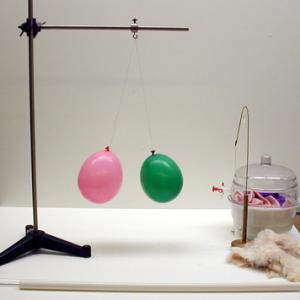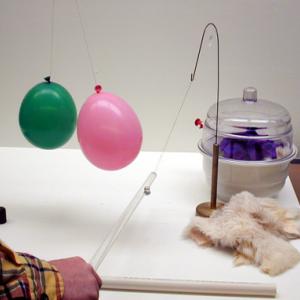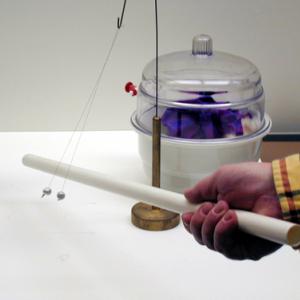College of Liberal Arts & Sciences
5A20.20 - Electrostatics - Pith Balls, Balloons
During high humidity months the cats fur and silk cloth should be dissected overnight.
The glass rod and silk as well as the clear Lucite rod and silk will give a positive charge.
The ebonite and cats fur will be negatively charged as will the PVC rod and cats fur.
The Lucite and PVC rods will be charged only where the rod was rubbed.
A set of balloons on strings can also act like a large set of pith balls when charged.
Once the set of pith balls or balloons have the same charge they should repel each other and be attracted to a rod of the opposite charge. A rod with the same charge as the pith balls should show repulsion.
- Francisco Vera, Rodrigo Rivera, Manuel Ortiz, Francisco Antonio Horta-Rangel, "Robust Triboelectric Charging of Identical Balloons of Different Radii", TPT, Vol. 60, #4, April 2022, p. 246.
- Mike Shaw, "Roll Over, Rover", TPT, Vol. 49, #4, Apr. 2011, p. 248.
- Peretz D. Partensky and Michael B. Partensky, "Hanging by a Thread", TPT, Vol. 44, #2, Feb. 2006, p. 88.
- William J. Muha, "Electroscope Shadowgraph", TPT, Vol. 6, #4, Apr. 1968, p. 179, also A Potpourri of Physics Teaching Ideas - Electricity and Magnetism, p. 131.
- Paul J. Dolan, Jr., "Comment on "Walking a Charged Pith Ball Perpendicular to an Electric Field" ", AJP, Vol. 69, #12, Dec. 2001, 1283.
- P. J. Ouseph, C. L. Davis, "Walking a Charged Pith Ball Perpendicular to an Electric Field", AJP, Vol. 69, #1, Jan. 2001, p. 88.
- P. H. Wiley and W. L. Stutzman, "A Simple Experiment to Demonstrate Coulomb's Law", AJP, Vol. 46, #11, Nov. 1978, p. 1131.
- Ea-5: Freier and Anderson, A Demonstration Handbook for Physics.
- E-040: "Aluminized Ping Pong Balls", DICK and RAE Physics Demo Notebook.
- Tik Liem, "The Confused Pithball", Investigation to Science Inquiry, p. 243.
- Tik Liem, "The Balloon Electroscope", Investigation to Science Inquiry, p. 244.
- George M. Hopkins, "Frictional Electricity", Experimental Science, p. 359.
- John Henry Pepper, "Electricity", Cyclopadic Science Simplified, p. 232.
- David Kutliroff, "75, Electrostatics Demonstrations", 101 Classroom Demonstrations and Experiment For Teaching Physics, p. 164.
- Borislaw Bilash II and David Maiullo, "Charge It Up", A Demo a Day: A Year of Physics Demonstrations, p. 240.
- Janice VanCleave, "61, How to Charge a Balloon", Teaching the Fun of Physics, p. 97.
- Robert Ehrlich, "9.1 - Coulomb's Law", Why Toast Lands Jelly-Side Down, p. 146.
- "Charging Up", The Usborne Book of Science Experiments, p. 54.
- Janice VanCleave, "Close Encounter", Physics for Every Kid - 101 Easy Experiments in Motion, Heat, Light, Machines, and Sound, p. 28- 29.
- W. Bolton, "The Force Between Charges", Book 4 - Electricity, Physics Experiments and Projects, 1968, p. 19-21.
- Rudolf F. Graf, "Fill the Stocking", Safe and Simple Electrical Experiments, p. 7.
- Rudolf F. Graf, "How to Break Up a Friendship Between Two Balloons", Safe and Simple Electrical Experiments, p. 9.
- Rudolf F. Graf, "Bringing Two Balloons Back Together", Safe and Simple Electrical Experiments, p. 10.
- Rudolf F. Graf, "Experiments with Charged Grains", Safe and Simple Electrical Experiments, p. 21.
- Borislaw Bilash II, “Attracted or Distracted“, A Demo A Day – A Year of Physical Science Demonstrations, p. 270.
- Borislaw Bilash II, “Charged Balloons“, A Demo A Day – A Year of Physical Science Demonstrations, p. 274.
- Joseph Frick, "#230 thru 235 - Elder Pith, Silk, Glass, Gutta-Percha, Amalgam, The Use of Chains", Physical Technics: Or Practical Instructions for Making Experiments in Physics and the Construction of Physical Apparatus with the Most Limmited Means, p. 253 & 254.
- Joseph Frick, "#236 - Fundamental Experiments", Physical Technics: Or Practical Instructions for Making Experiments in Physics and the Construction of Physical Apparatus with the Most Limmited Means, p. 255.
- "Pith Ball Electrometer", Pike's Illustrated Catalogue of Scientific & Medical Instruments, 1984, p. 261.
Disclaimer: These demonstrations are provided only for illustrative use by persons affiliated with The University of Iowa and only under the direction of a trained instructor or physicist. The University of Iowa is not responsible for demonstrations performed by those using their own equipment or who choose to use this reference material for their own purpose. The demonstrations included here are within the public domain and can be found in materials contained in libraries, bookstores, and through electronic sources. Performing all or any portion of any of these demonstrations, with or without revisions not depicted here entails inherent risks. These risks include, without limitation, bodily injury (and possibly death), including risks to health that may be temporary or permanent and that may exacerbate a pre-existing medical condition; and property loss or damage. Anyone performing any part of these demonstrations, even with revisions, knowingly and voluntarily assumes all risks associated with them.


